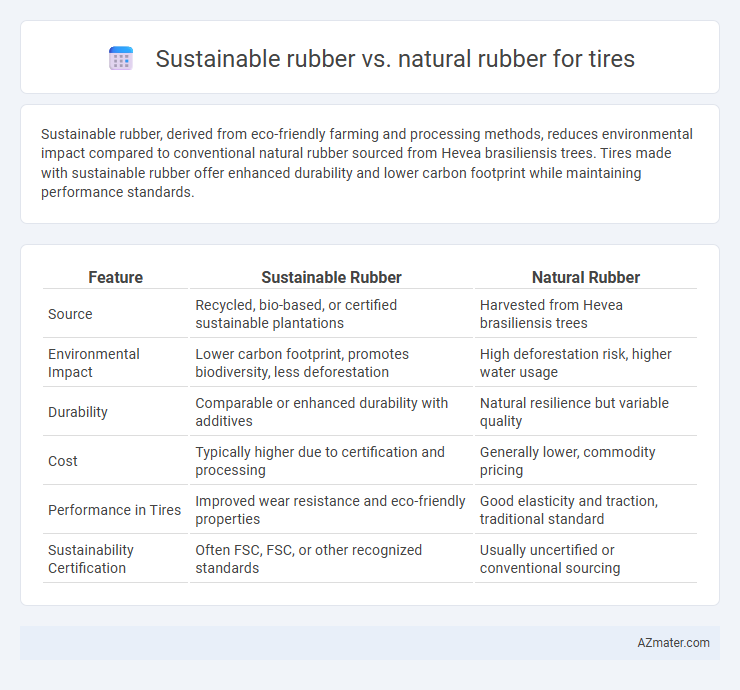Sustainable rubber, derived from eco-friendly farming and processing methods, reduces environmental impact compared to conventional natural rubber sourced from Hevea brasiliensis trees. Tires made with sustainable rubber offer enhanced durability and lower carbon footprint while maintaining performance standards.
Table of Comparison
| Feature | Sustainable Rubber | Natural Rubber |
|---|---|---|
| Source | Recycled, bio-based, or certified sustainable plantations | Harvested from Hevea brasiliensis trees |
| Environmental Impact | Lower carbon footprint, promotes biodiversity, less deforestation | High deforestation risk, higher water usage |
| Durability | Comparable or enhanced durability with additives | Natural resilience but variable quality |
| Cost | Typically higher due to certification and processing | Generally lower, commodity pricing |
| Performance in Tires | Improved wear resistance and eco-friendly properties | Good elasticity and traction, traditional standard |
| Sustainability Certification | Often FSC, FSC, or other recognized standards | Usually uncertified or conventional sourcing |
Introduction to Rubber Types in Tire Manufacturing
Natural rubber, harvested from the Hevea brasiliensis tree, offers excellent elasticity and resilience crucial for tire performance. Sustainable rubber incorporates innovative cultivation and processing methods to reduce environmental impact while maintaining key physical properties. Tire manufacturers increasingly favor sustainable rubber to meet eco-friendly standards without compromising durability and grip.
What Is Natural Rubber?
Natural rubber, derived from the latex sap of the Hevea brasiliensis tree, is a renewable biopolymer extensively used in tire manufacturing for its exceptional elasticity, resilience, and wear resistance. Sustainable rubber incorporates natural rubber with environmentally friendly practices such as agroforestry, reduced chemical usage, and fair labor conditions to minimize ecological impact and improve supply chain transparency. The shift towards sustainable rubber aims to preserve biodiversity and reduce deforestation while maintaining the performance standards required for high-quality tire production.
Defining Sustainable Rubber
Sustainable rubber is derived from responsibly managed plantations that prioritize environmental preservation, social equity, and economic viability, contrasting with conventional natural rubber often linked to deforestation and biodiversity loss. It incorporates eco-friendly practices such as reduced chemical use, water conservation, and fair labor conditions to minimize its carbon footprint throughout the supply chain. Tire manufacturers increasingly adopt sustainable rubber to meet regulatory standards, improve brand reputation, and support circular economy initiatives in the automotive industry.
Key Differences Between Natural and Sustainable Rubber
Natural rubber is harvested primarily from Hevea brasiliensis trees through traditional tapping methods, whereas sustainable rubber emphasizes eco-friendly practices such as agroforestry, reduced chemical use, and carbon footprint minimization. Sustainable rubber integrates certifications like FSC or Rainforest Alliance, ensuring responsible sourcing that helps preserve biodiversity and promotes social welfare. While natural rubber offers high elasticity and resilience essential for tire performance, sustainable rubber balances these properties with environmental impact reduction and enhanced supply chain transparency.
Environmental Impact: Natural vs Sustainable Rubber
Sustainable rubber significantly reduces deforestation, biodiversity loss, and carbon emissions compared to traditional natural rubber production, which often involves extensive clearing of tropical forests. By implementing agroforestry practices and using certified sustainable sources, sustainable rubber enhances soil health and conserves water resources. These eco-friendly methods contribute to a lower environmental footprint in tire manufacturing, promoting long-term ecological balance.
Performance Comparison in Tire Applications
Sustainable rubber, derived from innovative agroforestry practices and enhanced biopolymer extraction, offers comparable tensile strength and abrasion resistance to natural rubber in tire manufacturing. Performance tests reveal sustainable rubber maintains similar rolling resistance and wet grip levels, critical for tire safety and fuel efficiency. Lifecycle assessments indicate tires made with sustainable rubber provide reduced environmental impact without compromising durability or traction.
Supply Chain and Sourcing Challenges
Sustainable rubber, often sourced through certified agroforestry practices and recycled materials, addresses environmental concerns but faces complex supply chain challenges including traceability, higher costs, and limited production scale compared to traditional natural rubber. Natural rubber relies heavily on smallholder farmers in Southeast Asia, where inconsistent yields, susceptibility to diseases, and price volatility disrupt steady sourcing and supply reliability. Both materials demand enhanced transparency, investment in sustainable practices, and collaboration across multiple supply chain tiers to meet growing tire industry demands while ensuring ecological responsibility.
Economic Considerations for Manufacturers
Sustainable rubber offers tire manufacturers long-term cost benefits by reducing reliance on volatile natural rubber markets, which are subject to price fluctuations due to climate and geopolitical factors. Investing in sustainable rubber sources, such as rubber from agroforestry or recycled materials, can stabilize raw material expenses and enhance supply chain resilience. These economic advantages improve profitability while aligning with growing consumer demand for eco-friendly tire products.
Industry Initiatives Promoting Sustainable Rubber
Industry initiatives such as the Global Platform for Sustainable Natural Rubber (GPSNR) and the Sustainable Natural Rubber Initiative (SNR-i) advance the adoption of sustainable rubber by setting environmental and social standards for tire manufacturers. Major tire companies, including Bridgestone, Michelin, and Goodyear, commit to sourcing sustainable rubber that reduces deforestation, promotes biodiversity, and improves smallholder livelihoods. These collaborative efforts foster transparency and traceability in the supply chain, supporting the tire industry's transition from conventional natural rubber to sustainable alternatives.
Future Trends in Tire Rubber Sustainability
Sustainable rubber, derived from innovative cultivation practices and alternative sources such as guayule and dandelion, is rapidly gaining traction to reduce environmental impact compared to traditional natural rubber sourced primarily from Hevea trees. Advances in biotechnology and synthetic biology are enabling the development of high-performance sustainable rubber with comparable elasticity, durability, and grip for tire applications. Future trends indicate increased investment in circular economy models, enhanced traceability through blockchain technology, and regulatory pressures driving tire manufacturers to adopt sustainable rubber to meet global carbon neutrality targets.

Infographic: Sustainable rubber vs Natural rubber for Tire
 azmater.com
azmater.com